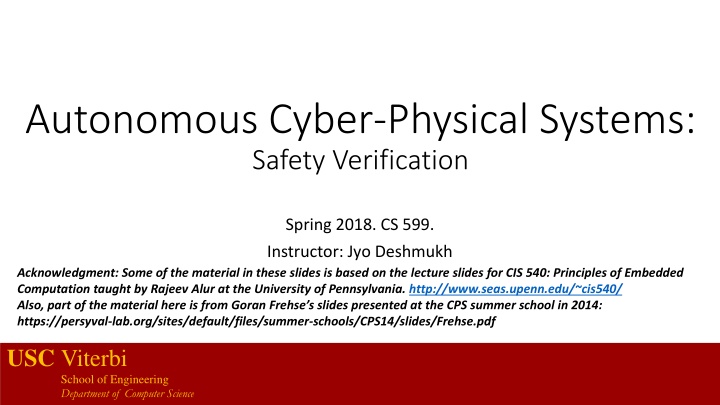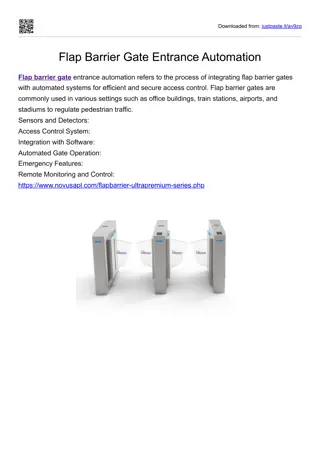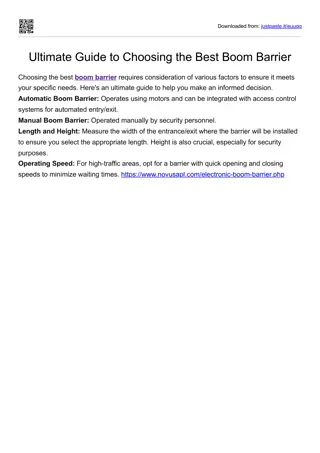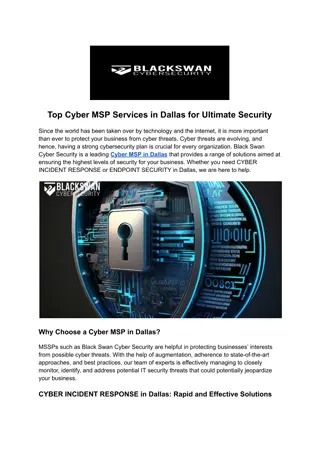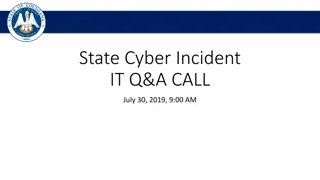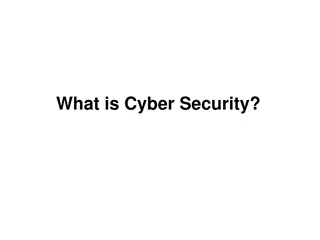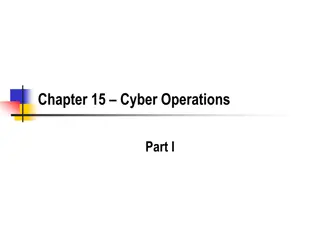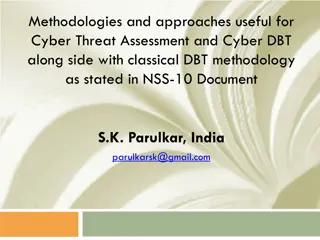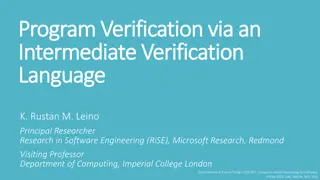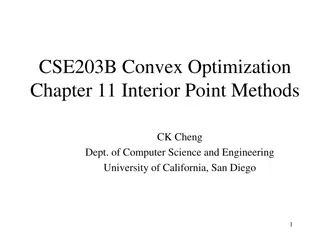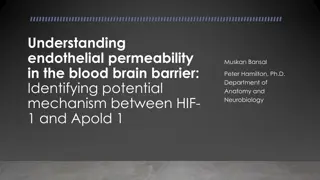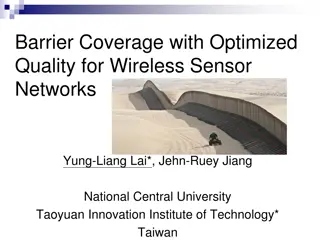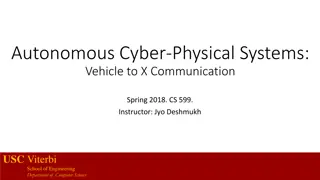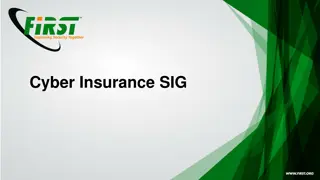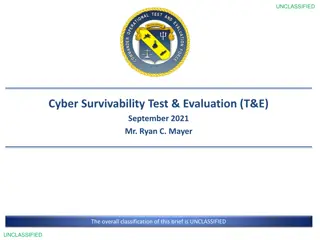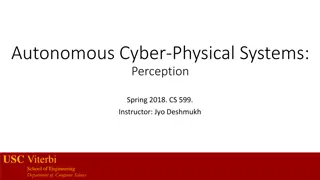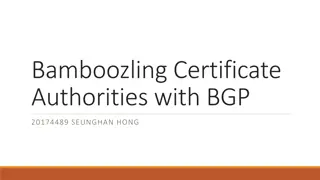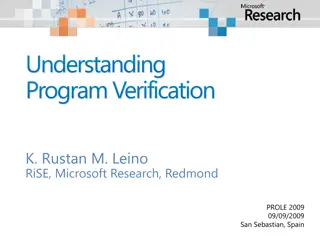Safety Verification Using Barrier Certificates in Autonomous Cyber-Physical Systems
Safety verification in autonomous cyber-physical systems involves the use of barrier certificates, which act as safety invariants for continuous dynamical systems. These certificates establish invisible barriers that trajectories cannot cross, ensuring system safety. By defining strict barrier conditions and validating initial and unsafe states, barrier certificates help ensure system safety by guiding trajectories to stay within safe boundaries. Practical examples illustrate how barrier certificates are used for safety verification in complex systems.
Download Presentation

Please find below an Image/Link to download the presentation.
The content on the website is provided AS IS for your information and personal use only. It may not be sold, licensed, or shared on other websites without obtaining consent from the author.If you encounter any issues during the download, it is possible that the publisher has removed the file from their server.
You are allowed to download the files provided on this website for personal or commercial use, subject to the condition that they are used lawfully. All files are the property of their respective owners.
The content on the website is provided AS IS for your information and personal use only. It may not be sold, licensed, or shared on other websites without obtaining consent from the author.
E N D
Presentation Transcript
Autonomous Cyber-Physical Systems: Safety Verification Spring 2018. CS 599. Instructor: Jyo Deshmukh Acknowledgment: Some of the material in these slides is based on the lecture slides for CIS 540: Principles of Embedded Computation taught by Rajeev Alur at the University of Pennsylvania. http://www.seas.upenn.edu/~cis540/ Also, part of the material here is from Goran Frehse s slides presented at the CPS summer school in 2014: https://persyval-lab.org/sites/default/files/summer-schools/CPS14/slides/Frehse.pdf USC Viterbi School of Engineering Department of Computer Science
Overview Last lecture Falsification (Requirements-driven Testing) Requirement Mining This lecture Safety Verification using Barrier Certificates Safety Verification using Reachability Analysis Simulation-guided Reachability Analysis USC Viterbi School of Engineering Department of Computer Science 2
Safety verification using barrier certificates Barrier certificate: safety invariant for a continuous dynamical system It establishes an invisible barrier that trajectories of a system cannot cross (think of it as a force-field) Reasoning very similar to that of an inductive invariant Establish that the initial states all lie within the barrier Establish that the unsafe states are all outside the barrier Show that the next states for all states on the barrier are inside the barrier USC Viterbi School of Engineering Department of Computer Science 3
Strict barrier certificate Given system ? = ?(?) Function ?(?) that serves as a classifier between good and bad states Unsafe Barrier conditions: 1. ? ?0:? ? 0 2. ? ??????:? ? > 0 3. ? ?:? ? = 0 ?? (The last condition models the barrier pushing the system back!) Initial ??? ? < 0 USC Viterbi School of Engineering Department of Computer Science 4
Example Unsafe ?1= ?1; ?2= ?1 ?2 Initial state set: ?1 Unsafe set: ?1 Barrier: ? ?1,?2 = 2?1 From plot: for initial states, ? ? < 0, for unsafe states, ? ? > 0 Barrier 2+ ?2 2> 4 2< 1/4 2+ ?2 Initial 2+ 2?1?2+ 3?2 2 3 USC Viterbi School of Engineering Department of Computer Science 5
Example Barrier ?1 ?1 ?2 = Finally, ?? ??? ? = [4?1+ 2?2 4?1 2?1 (2?1 3 4?1 From the plot, the above function is always negative for values of ?1,?2 where ? ? = 0 2?1+ 6?2] 2 2?1?2+ 2?1 2+ 2?1?2 6?2 2+ 2?1?2+ 3?2 2+ 9?2 2 2?1?2+ 6?1?2 6?2 2 = 2) 4?1 2= 2+ 9?2 2 = 2 USC Viterbi School of Engineering Department of Computer Science 6
Time-bounded Reachability Verification basics and Hybrid Systems lecture: reachability analysis using a fix-point based algorithm uses a breadth-first approach to compute reachable states over an infinite time-horizon Barrier certificates: also provide infinite time safety results, but require manual ingenuity in coming up with a barrier; difficult to do for hybrid/nonlinear systems Time-bounded reachability: Starting from some initial state in a given set of initial states, does the system behavior ever reach an unsafe state within a given time bound? USC Viterbi School of Engineering Department of Computer Science 7
Problem definition Let (?0,?) be the solution trajectory of a given dynamical system (could be nonlinear, hybrid, timed, ) when the system starts in initial state ?0 Time-bounded reachability: Prove that: ?0 ?0: ? 0,? : ?0,? ?????? Counterexample to time-bounded reachability shown below Trajectory segment with safe states Trajectory segment with unsafe states ?0 Unsafe (?0,0) (?0, ?) (?0,?) ? ?0 ? [0,?] USC Viterbi School of Engineering Department of Computer Science 8
Solutions to time-bounded reachability To solve time-bounded reachability exactly: Compute set of all states reachable from ?0: ReachTQ0 = ?| ? = ?0,? ,?0 ?0,? [0,?] Check if ReachTQ0 ?????? is empty Challenge: computing ReachTQ0 is very hard (even for the simplest case of general linear dynamical systems) Instead, we focus on approximating ReachT?0 Under-approximation Over-approximation Combination of both USC Viterbi School of Engineering Department of Computer Science 9
Under-approximation When we under-approximate the set of initial states, at each time, the set of reachable states that we compute is a subset of the actualset of reachable states Best example of under-approximation is (guaranteed) numerical simulation Guaranteed numerical simulation: better than numerical integration schemes as it gives bounds on error in numerical integration (e.g. VNODE) Under-approximation is: Sound for bug-finding: if we find a bug, then it is really a bug Unsound for verification: if we do not find a bug, does not mean the system is safe USC Viterbi School of Engineering Department of Computer Science 10
Under-approximation: sound for bug-finding The good case: under-approximation found a trace that contained unsafe states we found a bug in the system! ?????? ?0 USC Viterbi School of Engineering Department of Computer Science 11
Under-approximation: unsound for verification The bad case: under-approximation did not find a trace that contained unsafe states we cannot conclude anything. ?????? ?0 USC Viterbi School of Engineering Department of Computer Science 12
Over-approximation When we over-approximate the set of initial states, at each time, the set of reachable states that we compute is a superset of the actualset of reachable states Most formal verification techniques are based on over-approximation Over-approximation is: Unsound for bug-finding: if we find a bug, then it may not really be a bug Because of over-approximation error Sound for verification: if we do not find a bug, we have a proof that the system cannot reach an unsafe state in any time in 0,? USC Viterbi School of Engineering Department of Computer Science 13
Reachability for piecewise affine (PWA) systems PWA systems are a simplification of hybrid automata For a PWA system with ? modes: Each mode described by an affine invariant of the form ??? > ? In each mode the dynamics are described as: ? = ??? + ???+ ?? A lot of research over last 20 years on computing the set of reachable states for PWA systems Focus: reduce approximation error and increase scalability (in number of modes) Tools: PHAver, d/dt, CheckMate, SpaceEx USC Viterbi School of Engineering Department of Computer Science 14
Reachability for affine systems Recall that for a linear system (for now assume no inputs): ? ? = ?0??? Let ? = ?, now e?? is just some constant matrix ?3? ? ?2? If ?0 is some polyhedral set, we can compute the exact set of reachable states for every state in ?0 at time ?, because ?0??? is just a linear transform Thus, we get ??+1 ?= ????? ?? ?0 Could be acceptable for continuous systems: between discrete time steps, solution remains in the neighborhood of the aproximations ??? (and we can over-estimate this neighborhood numerically) ? USC Viterbi School of Engineering Department of Computer Science 15
Problem for CPS (hybrid systems) Controller may be event-triggered, where it detects the level of a certain physical quantity, and based on that changes mode of operation ?2? ? An event firing between consecutive time steps could take the PWA system in a different mode! We need to account for what may happen between time-steps ?? Wrong! This is done by covering the reach-sets computed at times ?? and ? + 1 ? by a shape that includes both ?0 Lots of research done on which shape is the best, and different shapes have different tradeoffs Ellipsoids, Zonotopes, Support Functions SpaceEx tool uses support functions, and is pretty accurate for reasonably sized PWA systems now ? USC Viterbi School of Engineering Department of Computer Science 16
Reachability for nonlinear systems Not all systems can be modeled as PWA! Nonlinear systems: Approach I: first PWA-ize the system, then do reachability. Drawback: Error encountered during PWA-ization accumulates Approach 2: use more interesting models such as Taylor models (based on Taylor series representations): used in tool Flow* Approach 3: throw the problem at a powerful nonlinear SMT solver: used in tool dReach USC Viterbi School of Engineering Department of Computer Science 17
Combining under and over-approximations Also known as simulation-guided reachability analysis Main idea: Sample some initial states, perform simulations starting from these states Use continuity -like arguments to bloat the trajectories in a sound manner If bloated trajectories cover initial state space, go to step 4, if not go back to step 1 If bloated trajectories do not intersect unsafe set, conclude system is safe. If bloated trajectories intersect unsafe set, try to refine bloated trajectories to check if there is a true counterexample 1. 2. 3. 4. USC Viterbi School of Engineering Department of Computer Science 18
Simlulation-guided reachability depiction Initial Simulation Trace up to time T Reach-Tube up to time T Unsafe USC Viterbi School of Engineering Department of Computer Science 19
Secret sauce: how to bloat Main idea: Solutions of ODEs are sensitive to their initial conditions Such sensitivity gives an estimate on how far two trajectories can go if they start ? apart A key notion is a discrepancy function ? that bounds how far trajectories can grow ?0,? ?0 Obtaining a ? that shows trajectories remain bounded within some reasonable factor of the distance between their initial conditions is very useful We only simulate from ?0, and we know how all neighbors of ?0 will behave! Technique implemented in tool C2E2 ,? ,? < ? ?0 ?0 USC Viterbi School of Engineering Department of Computer Science 20
Bibliography Breach : https://link.springer.com/chapter/10.1007/978-3-642-14295-6_17 1. Prajna, S., & Jadbabaie, A. (2004, March). Safety verification of hybrid systems using barrier certificates. In International Workshop on Hybrid Systems: Computation and Control (pp. 477-492). 2. Duggirala, Parasara Sridhar, et al. "C2E2: a verification tool for stateflow models." International Conference on Tools and Algorithms for the Construction and Analysis of Systems. 3. Frehse, Goran, Colas Le Guernic, Alexandre Donz , Scott Cotton, Rajarshi Ray, Olivier Lebeltel, Rodolfo Ripado, Antoine Girard, Thao Dang, and Oded Maler. "SpaceEx: Scalable verification of hybrid systems." In International Conference on Computer Aided Verification, pp. 379-395. Springer, Berlin, Heidelberg, 2011. 4. Chen, Xin, Erika brah m, and Sriram Sankaranarayanan. "Flow*: An analyzer for non-linear hybrid systems." In International Conference on Computer Aided Verification, pp. 258- 263. Springer, Berlin, Heidelberg, 2013. 5. Frehse, Goran. "PHAVer: Algorithmic verification of hybrid systems past HyTech." International workshop on hybrid systems: computation and control. Springer, Berlin, Heidelberg, 2005 6. Asarin, E., Dang, T., & Maler, O. (2002, July). The d/dt tool for verification of hybrid systems. In International Conference on Computer Aided Verification (pp. 365-370). Springer, Berlin, Heidelberg. 7. Fan, Chuchu, Bolun Qi, Sayan Mitra, Mahesh Viswanathan, and Parasara Sridhar Duggirala. "Automatic reachability analysis for nonlinear hybrid models with C2E2." In International Conference on Computer Aided Verification, pp. 531-538. Springer, Cham, 2016. 8. Donz , Alexandre, and Oded Maler. "Systematic simulation using sensitivity analysis." In International Workshop on Hybrid Systems: Computation and Control, pp. 174-189. Springer, Berlin, Heidelberg, 2007 9. USC Viterbi School of Engineering Department of Computer Science 21
